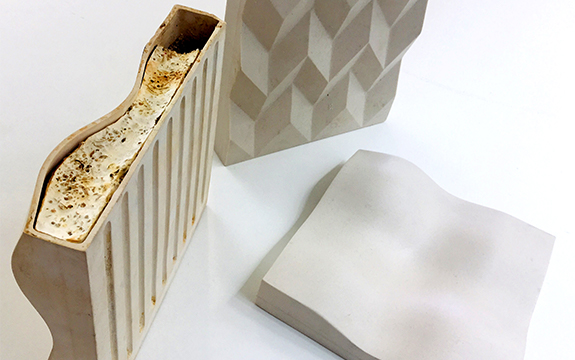Ceramic skins insulate and protect city buildings and inhabitants

Latifi’s hollow ceramic tile filled with mycelium, image by Mehrnoush Latifi.
In summary
- Latifi focuses on the design of ‘active skins’ for buildings
- Insulative and thermodynamic shells for buildings and structures
- Tiled skins create healthy microclimates for people in cities
Dr Mehrnoush Latifi Khorasgani is a Lecturer in Architecture at the Swinburne School of Design, and Theme Leader of the Smart Skins Smart(er) Cities research stream for Future Urban Infrastructure at the Swinburne Smart Cities Research Institute. She exhibited her Fireless Skin, a non-flammable skin for buildings, in a group exhibition with fellow designers and academics during Melbourne Design Week.
Latifi is a practising architect who bridges science and art in her creative practice. She investigates and develops ceramic skin systems that function as insulative and thermodynamic shells for buildings and structures. Her creative practice, research and teaching spans the fields of architecture, virtual and augmented reality, thermal comfort, microclimate design, and digital fabrication.

Illustration by Latifi showing her ceramic skin system on a building surface
When applied to the surfaces of buildings, her interlocking hollow ceramic tile systems provide protection from cold, heat and noise. Her Fireless Skin design is a system of hollow ceramic building tiles that are filled with mycelium to improve the thermal and acoustic properties of walls and structural surfaces. The tiles feature customisable decorative surfacing and glazing options created using digital and traditional production technologies.
Latifi is currently analysing the thermal performance of the ceramic-mycelium material at Swinburne. The Fireless Skin project has multiple collaborators researching ceramic, mycelium and the use of additives such as glass fines.
“The idea of looking at ceramic components as an active skin for buildings, to collect energy through a façade, or to use a biomaterial inside as an insulation layer is the main focus of my research at Swinburne,” Latifi explains.
“My research for Smart Skin Smarter Cities at the Swinburne Smart Cities Institute focuses on the design of ‘active skins’ for buildings. This is about using the skin of buildings as an opportunity to generate energy and to create pleasant microclimates for cities and inhabitants,” she says.

Stacked ceramic tiles at the Fireless Skin exhibition, photography by Mehrnoush Latifi

Assembled ceramic tiles with mycelium fill, at Fireless Skin exhibition, photography by Mehrnoush Latifi
With recent catastrophic failures of flammable cladding systems in Australia and overseas, Latifi says installing ceramic tile components filled with air or biomaterials such as mycelium (also making the components lighter), could be a viable alternative.
“Fully glazed facades are also problematic. They are turning our cities into jungles of iron and glass that can burn surrounding environments on hot days. Facade layering is an opportunity to not only protect people who are living and working inside a building but to also create pleasant microclimates in our cities,” says Latifi.
Read more news on design at Swinburne
-
Media Enquiries
Related articles
-

- Design
- Student News
How Hao Wei is uniting design and technology to solve problems
Hao Wei Tu enrolled in a study abroad program at Swinburne and is now pursuing a PhD with Swinburne’s School of Design and Architecture and Design Factory Melbourne
Thursday 20 November 2025 -

- Design
How design alum turned passion into a profession
Swinburne design alum Joanna Margiolis is combining her passions of design, photography and sport in her role as a creative specialist at Netball Australia.
Wednesday 03 September 2025 -

- Design
- University
Swinburne alum builds dream career LEGO brick by LEGO brick
Industrial design alum Miller Keys has moved to Denmark to live his childhood dream of being a LEGO designer at the headquarters of the world’s most iconic toy brand.
Tuesday 05 August 2025 -

- Design
- University
Swinburne industrial design alum spreading style
Director, designer and Swinburne alum Lachlan Mackay is making waves in the design industry with his studio Space-man Studio, making the 2025 Australian Design Review’s 30 Under 30 list.
Monday 28 July 2025 -

- University
- Design
Swinburne Design Factory Melbourne appoints new Innovation Fellow and Acting Director
Maureen Thurston, a global leader in innovating, by design, has been appointed as the new Acting Director of Swinburne’s Design Factory Melbourne and an Innovation Fellow.
Monday 03 February 2025

